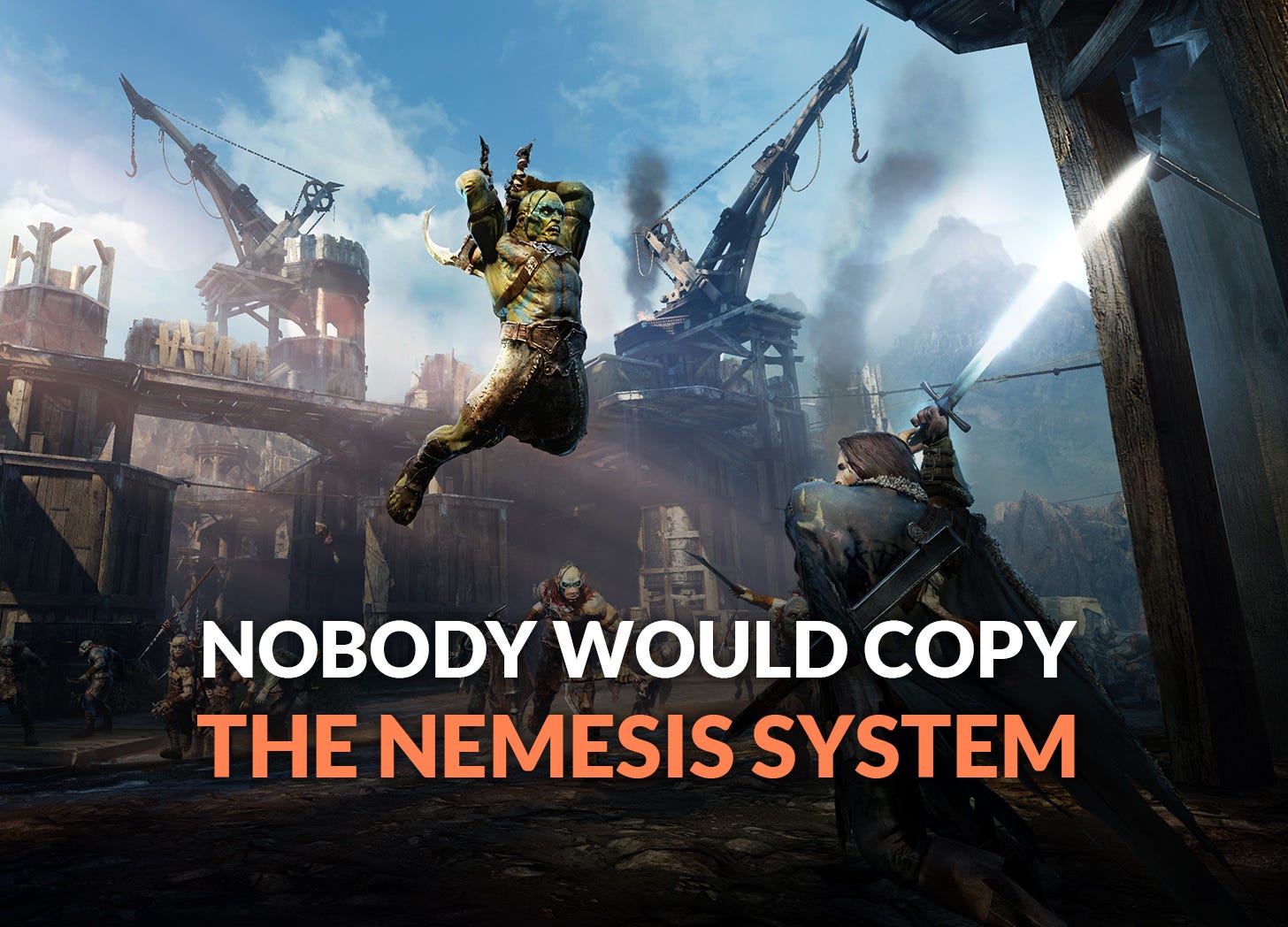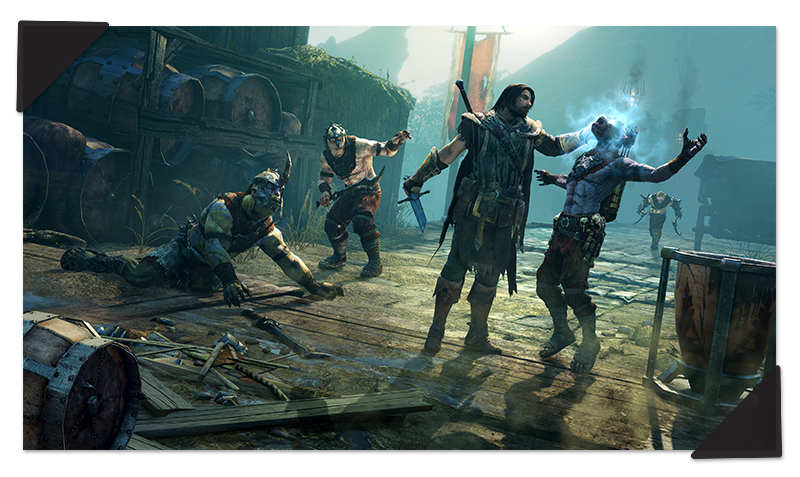Nobody Would Copy the Nemesis System Anyway
Why did Warner Bros bother to fill a patent for this system?
Few games in history simultaneously receive the titles of « uninspired ripoffs » and « innovation of the decade ».
In 2014, when Monolith Software announced its new game Shadow of Mordor, people quickly labelled it "Assassin's Creed in the Tolkien universe”. Fortunately, the game had a trick in its sleeve, the “Nemesis system”.
This inventive use of procedural enemies to generate varied content arose the imagination of journalists & players: could the idea transfer to other games? Warner Bros thought so, at least: they greenlit the sequel and planned to adapt the creation to other franchises.
The company also filed a patent, which got refused several times until it was finally validated in 2022, prompting an immediate outcry from the gaming world. Warner suddenly became the villain who hindered creativity in the industry by preventing games from pushing further the promising innovation.
Who wanted to re-use the Nemesis system, though? A lot of time has passed, and we're yet to put our hands on a meaningful successor to the Nemesis system, which isn't surprising to me.
The Most Expansive Side Content Generator
At its core, the role of the Nemesis system is to procedurally generate characters to populate the open world and create meaningful stories when they interact together (and with the player).
Each region has 25 captains with a unique appearance and set of gameplay abilities (strengths, weaknesses, etc.). Each has a place in the orc hierarchy, influencing how they interact with one another and the activities they engage in: rivals are constantly duelling or ambushing one another, a greedy bodyguard may betray its war chief, and anyone could train or feast. The fight for the high ranks never ends: even if the player doesn't do anything, the microcosm evolves.
In that regard, the Nemesis system provides a fantastic simulation to breathe life into enemies even when the player doesn't meet them directly. Regional mini-bosses are a staple of the open-world design, but unlike the lieutenants in Far Cry or Ghost Recon: Wildlands, the captains here feel active. They aren't just waiting in their fortress for the moment (or mission) when you come to fight them.
The player is also encouraged to mess up with the captain's hierarchy to facilitate their own goals. For instance, they can identify and eliminate the bodyguards of a powerful war chief to ease future encounters or, once the ability is unlocked, they can even mind-control to send them a betrayal assassination. The hierarchy menu becomes as essential as the game map, exposing clearly the consequences of your deeds and fueling your motivation to interact with them.
In essence, Nemesis is a set of procedural open-world activities with all the ingredients to succeed: easy-to-follow narratives, an addictive game loop, a dose of suspense (you have blacked-out silhouettes until you investigate who is who), and some variety in the encounters. Yes, it creates memorable anecdotes like no other, but still, we can't over-estimate its role & limits in the over-arching game structure.
The Limits & Illusions of Procedural Generation
Shadow of Mordor isn't just similar to Assassin's Creed when it comes to climbing animations and air assassinations: it also ticks all the boxes of the ‘formulaic open world’ blueprint: main story, side quests, tons of collectables, light RPG progression, etc. This structure is particularly effective in flooding the player's experience with content but therefore comes with the inconvenience of letting little space for the Nemesis system to breathe.
Although this was improved in the sequel, engaging with the captain's hierarchy felt more like a fun distraction than the promised core. The scripted main missions serve as a gigantic tutorial to introduce the system, but no matter your Nemesis state, the story unfolds the same way. Since the narrative twists are pre-determined and the best upgrades (such as the aforementioned mind control) are gated behind story progress anyway, you’re almost discouraged from toying with the system unless the story says so.
Why couldn't the Nemesis influence the experience more?
As a player, it's so frustrating to see it constrained to the function of an entertaining side-quest generator. As a designer though, I can understand why its place is tricky: Shadow of Mordor doesn't offer the crazy depth and playstyle variety of a proper RPG or a Mount & Blade, so it risks getting repetitive eventually.
When engaging with the system, your primary motivation is to discover new traits, those defining elements that make a character completely unique. Encountering a new combination of previously-encountered traits may technically create a new “unique” enemy, but it doesn’t feel that different.
Monolith Software knew that, of course, so they fed the system with handcrafted elements designed specifically to generate memorable moments, such as the possibility for captains to cheat death and seek revenge. Every player will remember that one, but few would recall the unique combination of twenty traits of even their greatest rival.
When you're done with the game, you have a hard time comparing your journey with your friends and it feels like you’ve all experienced roughly the same content, in a different order. It's a common issue with procedural systems: they are good at providing variations but, ultimately, their strength depends on the depth of content they can offer. One may even wonder if Shadow of Mordor would be better with handcrafted captains.
Innovations Worth Copying
So, back to the premise: what is the point of recreating a game system that already exists, has already delivered its promise and has begun to show its limits in just two games?
If you're Warner Bros, you can at least use the word ‘Nemesis’ to draw attention (like they did for the elusive Wonder Woman game), but you'd still need to explain how the system translates to an orc-less universe.
For anyone else, ‘Nemesis system’ was a deposed trademark before the patent: would you really build a game around a system you can't name explicitly? And by the way, since it's no longer unique, it's not a great marketing hook.
Shadow of Mordor two main selling points are its genre (open-world action adventure) and its franchise, therefore I seriously doubt there's a large group of nostalgic waiting for more Nemesis.
The procedural system was the ‘cherry on top’, a worthy investment to differentiate the game on its market, but not a sufficient argument to spawn a whole new genre.
If you have the skills and the vision to produce ambitious procedural systems, you'd use the inspiration but make something different (like Ubisoft did with Watch Dogs Legion) and, therefore, won't have to worry about the Nemesis patent. As I said, I don’t see how Warner hinders anyone creativity here.
One Last Word
I realise I sound like I dismiss the achievements of the Nemesis, but believe me, I was hooked when I discovered it and its design still fascinates me to this day. I could have deconstructed the system's intricacies, but there are great videos on the topic already. Hence, I preferred to approach the subject from a different angle, with an opinion that feels unpopular compared to what I read online.
We should admire and remember how Monolith went the extra mile to include a well-executed and highly-thematic system. It doesn't need to appear in other games to have a legacy: it already had an essential impact on the industry. I wouldn't be surprised to hear many creators mentioning it as an influence on their systemic creations.
If you liked the topic of this article, I’m sure you’d also enjoy this one:













